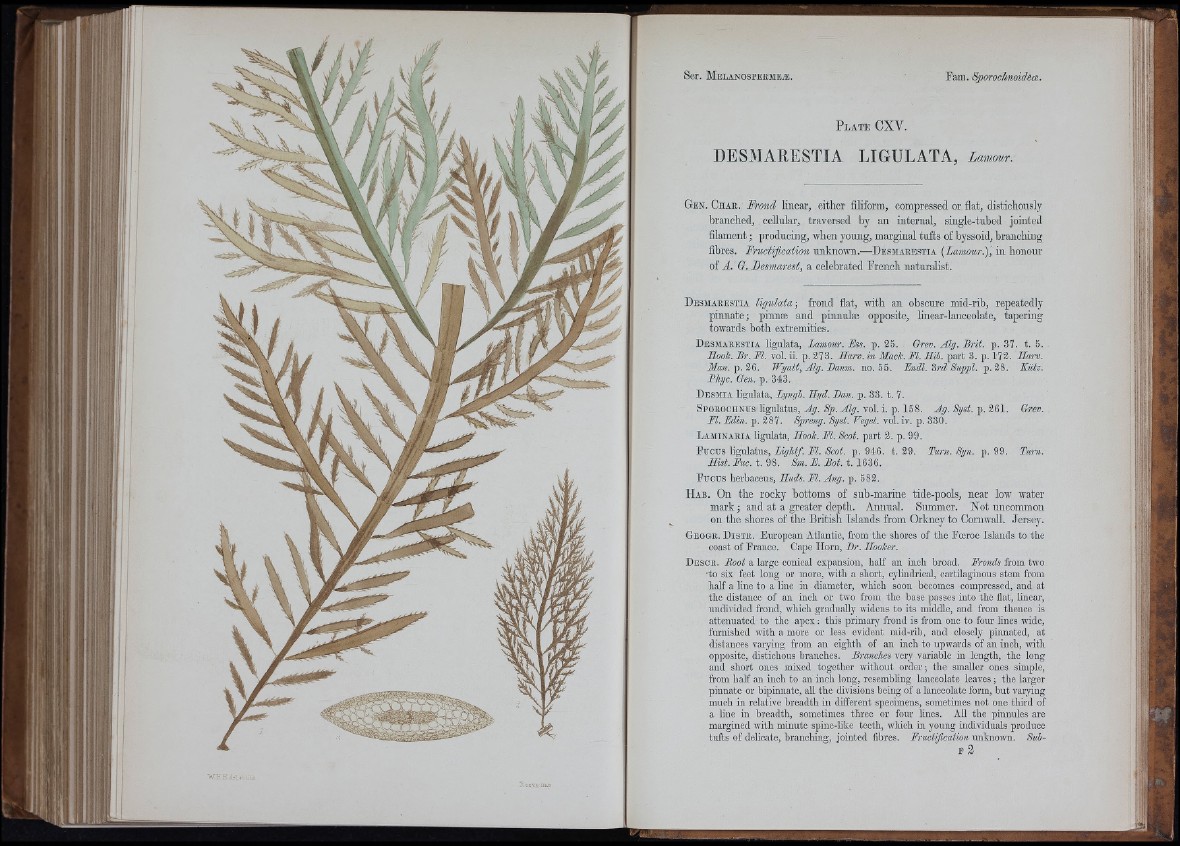
I '
P la t e CXV.
DESMARESTIA LIGULATA, Lamour.
Gen. C h a e . Frond linear, either filiform, compressed or fiat, distichously
branched, cellular, traversed by an internal, single-tubed jointed
filament; producing, when young, marginal tufts of byssoid, branching
fibres. Fructification unknown.—D e sm a re s tia [Lamour.), in honour
of A. 0 . Lesmarest, a celebrated French naturalist.
D e sm a re s tia ligulata; frond flat, with an obscure mid-rib, repeatedly
pinnate; pinnæ and pinnulæ opposite, linear-lanceolate, tapermg
towards both extremities.
Desmarestia ligulata, Lamour. Ess. p. 25. Grev. Alg. Brit. p. 37. t. 5.
Hoolc. Br. M. vol. ii. p. 273. Harv. in Mack. M. Hih. part 3. p. 173. Harv.
Man.-g. 26. Wyatt, Alg. Banm. no. 55. Endl. 3rd Suppl. p. 28. Kiitz.
Bhyc. Gen. p. 343.
D e sm ia lig u la ta , Lyngh. Hyd. Ban. p . 3 3 . t. 7.
Sporochnus ligulatus, Ag. Sp. Alg. vol. i. p. 158. Ag. Syst. p. 261. Grev.
El. Bdin. p. 287- Spreng. Syst. Veget. vol. iv. p. 330.
L aminaria ligulata, Hook. M. Scot. part 2. p. 99.
Fuous bgulatus, Lightf. El. Scot. p. 946. t. 29. Turn. Syn. p. 99. Turn.
Hist. Eue. t. 98. Sm. E. Bot. t. 1636.
Fu ous berbaceus, Huds. El. Ang. p. 582.
H a b . On tbe rooky bottoms of sub-marine tide-pools, near low water
mark; and at a greater depth. Annual. Summer. Not uncommon
on the shores of tbe British Islands from Orkney to Cornwall. Jersey.
Geogr. Distr. European Atlantic, from the shores of the Foeroe Islands to the
coast of France. Cape Horn, Br. Hooker.
Descr. Root a large conical expansion, half an inch broad. Eronds from two
■to six feet long or more, with a short, cylindrical, cartilaginous stem from
half a line to a line in diameter, which soon becomes compressed, and at
the distance of an inch or two from the base passes into the flat, linear,
undivided frond, which gradually widens to its middle, and from thence is
attenuated to the apex : this primiuy frond is from one to fom- lines wide,
furmshed with a more or less evident mid-rib, and closely pinnated, at
distances varying from an eighth of an inch to upwards of an inch, unth
opposite, distichous branches. Branches very variable in length, the long
and short ones mixed together without order ; the smaller ones simple,
from half an inch to an inch long, resembling lanceolate leaves ; the larger
pinnate or bipinnate, aU the divisions being of a lanceolate form, but varying
much in relative breadth in different specimens, sometimes not one third of
a line in breadth, sometimes three or four lines. All the pinnules are
margined with minute spine-like teeth, which in young individuals produce
tufts of delicate, branching, jointed flbres. Eructification unknown. Suh